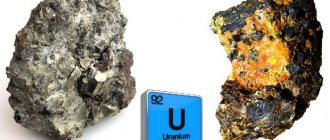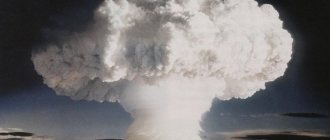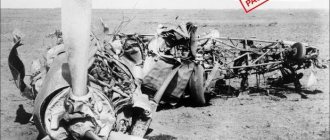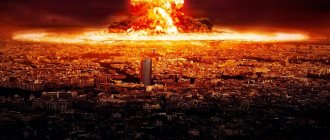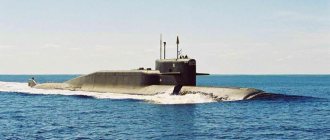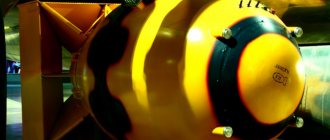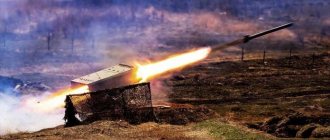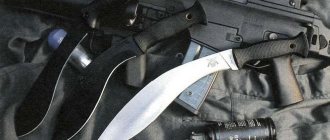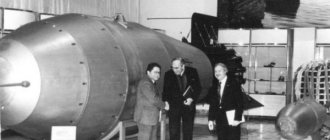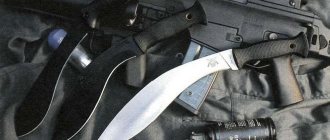After the end of World War II, the countries of the anti-Hitler coalition rapidly tried to get ahead of each other in the development of a more powerful nuclear bomb.
The first test, carried out by the Americans on real objects in Japan, heated the situation between the USSR and the USA to the limit. Powerful explosions that thundered through Japanese cities and practically destroyed all life in them forced Stalin to abandon many claims on the world stage. Most Soviet physicists were urgently “thrown” into the development of nuclear weapons.
When and how did nuclear weapons appear?
The year of birth of the atomic bomb can be considered 1896. It was then that the French chemist A. Becquerel discovered that uranium is radioactive. The chain reaction of uranium creates powerful energy, which serves as the basis for a terrible explosion. It is unlikely that Becquerel imagined that his discovery would lead to the creation of nuclear weapons - the most terrible weapon in the whole world.
The end of the 19th and beginning of the 20th century was a turning point in the history of the invention of nuclear weapons. It was during this time period that scientists from around the world were able to discover the following laws, rays and elements:
- Alpha, gamma and beta rays;
- Many isotopes of chemical elements with radioactive properties were discovered;
- The law of radioactive decay was discovered, which determines the time and quantitative dependence of the intensity of radioactive decay, depending on the number of radioactive atoms in the test sample;
- Nuclear isometry was born.
In the 1930s, they were able to split the atomic nucleus of uranium for the first time by absorbing neutrons. At the same time, positrons and neurons were discovered. All this gave a powerful impetus to the development of weapons that used atomic energy. In 1939, the world's first atomic bomb design was patented. This was done by a physicist from France, Frederic Joliot-Curie.
As a result of further research and development in this area, a nuclear bomb was born. The power and range of destruction of modern atomic bombs is so great that a country that has nuclear potential practically does not need a powerful army, since one atomic bomb can destroy an entire state.
How does an atomic bomb work?
An atomic bomb consists of many elements, the main ones being:
- Atomic bomb body;
- Automation system that controls the explosion process;
- Nuclear charge or warhead.
The automation system is located in the body of the atomic bomb, along with the nuclear charge. The design of the housing must be reliable enough to protect the warhead from various external factors and influences. For example, various mechanical, temperature or similar influences, which can lead to an unplanned explosion of enormous power that can destroy everything around.
The task of automation is full control over ensuring that the explosion occurs at the right time, so the system consists of the following elements:
- A device responsible for emergency detonation;
- Automation system power supply;
- Detonation sensor system;
- Cocking device;
- Safety device.
When the first tests were carried out, nuclear bombs were delivered on airplanes that managed to leave the affected area. Modern atomic bombs are so powerful that they can only be delivered using cruise, ballistic or at least anti-aircraft missiles.
Atomic bombs use various detonation systems. The simplest of them is a conventional device that is triggered when a projectile hits a target.
One of the main characteristics of nuclear bombs and missiles is their division into calibers, which are of three types:
- Small, the power of atomic bombs of this caliber is equivalent to several thousand tons of TNT;
- Medium (explosion power – several tens of thousands of tons of TNT);
- Large, the charge power of which is measured in millions of tons of TNT.
It is interesting that most often the power of all nuclear bombs is measured precisely in TNT equivalent, since atomic weapons do not have their own scale for measuring the power of the explosion.
Relative efficiency coefficient [edit]
The relative efficiency factor (RE factor) relates the destructive power of an explosive and TNT in units of TNT equivalent/kg (TNTe/kg). The RE factor is the relative mass of TNT that the explosive is equivalent to: the higher the RE, the more powerful the explosive.
This allows engineers to determine the correct masses for various explosives when applying blasting formulas developed specifically for TNT. For example, if the logging formula calls for a charge of 1 kg of TNT, then based on octanitrocubane's RE factor of 2.38, only 1.0/2.38 (or 0.42) kg of it would be needed to do the same job. When using PETN, engineers would need 1.0/1.66 (or 0.60) kg to produce the same effects as 1 kg of TNT. With ANFO or ammonium nitrate they will need 1.0/0.74 (or 1.35) kg or 1.0/0.32 (or 3.125) kg respectively.
However, it is not possible to calculate a single RE factor for an explosive.
It depends on the specific case or use. Given a pair of explosives, it is possible to produce twice the power of the shock wave (this depends on the distance to the measuring instruments), but the difference in straight metal cutting ability can be 4 times higher for one type of metal and 7 times higher for another type. metal. The relative differences between two explosives with shaped charges will be even greater. The table below should be considered an example and not an exact source of data. Some examples of relative efficiency factors [ citation needed
]
| Explosive, grade | Density (g/ml) | Detonation level. (RS) | Relative efficiency |
| Ammonium nitrate (AN + <0.5% H 2 O) | 0,88 | 2700 [34] | 0,32 [35] [36] |
| Mercury (II) lightning fast | 4,42 | 4250 | 0,51 [37] |
| Black powder (75% KNO 3 + 19% C + 6% S, ancient explosives) | 1,65 | 600 | 0,55 [38] |
| Tanerit Simply (93% granular AN + 6% red P + 1% C) | 0,90 | 2750 | 0,55 |
| Hexamine dinitrate (HDN) | 1,30 | 5070 | 0,60 |
| Dinitrobenzene (DNB) | 1,50 | 6025 | 0,60 |
| HMTD (hexamine peroxide) | 0,88 | 4520 | 0,74 |
| ANFO (94% AN + 6% fuel oil) | 0,92 | 5270 | 0,74 |
| TATP (acetone peroxide) | 1.18 | 5300 | 0,80 |
| Tovex Extra (water gel) commercial product, | 1,33 | 5690 | 0,80 |
| Hydromite 600 (water emulsion) commercial product, | 1,24 | 5550 | 0,80 |
| ANNMAL (66% AN + 25% NM + 5% Al + 3% C + 1% TETA) | 1,16 | 5360 | 0,87 |
| Amatol (50% TNT + 50% AN) | 1,50 | 6290 | 0,91 |
| Nitroguanidine | 1,32 | 6750 | 0,95 |
| Trinitrotoluene (TNT) | 1,60 | 6900 | 1,00 |
| Hexanitrostilbene (HNS) | 1,70 | 7080 | 1.05 |
| Nitrourea | 1,45 | 6860 | 1.05 |
| Tritonal (80% TNT + 20% aluminum) * | 1,70 | 6650 | 1.05 |
| Nickel hydrazine nitrate (NHN) | 1,70 | 7000 | 1.05 |
| Amatol (80% TNT + 20% AN) | 1,55 | 6570 | 1,10 |
| Nitrocellulose (13.5% N, NC; AKA Guncotton) | 1,40 | 6400 | 1,10 |
| Nitromethane (NM) | 1.13 | 6360 | 1,10 |
| PBXW-126 (22% NTO, 20% RDX, 20% AP, 26% Al, 12% PU in system)* | 1,80 | 6450 | 1,10 |
| Diethylene glycol dinitrate (DEGDN) | 1,38 | 6610 | 1.17 |
| PBXIH-135 EB (42% HMX, 33% Al, 25% PCP - TMETN system) * | 1,81 | 7060 | 1.17 |
| PBXN-109 (64% RDX, 20% Al, 16% HTPB in system) * | 1,68 | 7450 | 1.17 |
| Triaminotrinitrobenzene (TATB) | 1,80 | 7550 | 1.17 |
| Picric Acid (TNP) | 1,71 | 7350 | 1.17 |
| Trinitrobenzene (TNB) | 1,60 | 7300 | 1,20 |
| Tetritol (70% tetryl + 30% TNT) | 1,60 | 7370 | 1,20 |
| Dynamite, Nobel (75% NG + 23% diatomite) | 1,48 | 7200 | 1,25 |
| Tetryl | 1,71 | 7770 | 1,25 |
| Torpex (also known as HBX, 41% RDX + 40% TNT + 18% Al + 1% wax) * | 1,80 | 7440 | 1,30 |
| Composition B (63% RDX + 36% TNT + 1% wax) | 1,72 | 7840 | 1,33 |
| Composition C-3 (78% RDX) | 1,60 | 7630 | 1,33 |
| Composition C-4 (91% RDX) | 1,59 | 8040 | 1,37 |
| Pentolite (56% PETN + 44% TNT) | 1,66 | 7520 | 1,33 |
| Semtex 1A (76% PETN + 6% hexogen) | 1,55 | 7670 | 1,35 |
| Hexal (76% RDX + 20% aluminum + 4% wax) * | 1,79 | 7640 | 1,35 |
| RISAL P (50% IPN + 28% RDX + 15% Al + 4% Mg + 1% Zr + 2% NC) * | 1,39 | 5980 | 1,40 |
| Hydrazine mononitrate | 1,59 | 8500 | 1,42 |
| Blend: 24% nitrobenzene + 76% TNM | 1,48 | 8060 | 1,50 |
| Mixture: 30% nitrobenzene + 70% nitrogen tetroxide. | 1,39 | 8290 | 1,50 |
| Nitroglycerin (NG) | 1,59 | 7700 | 1,54 |
| Methyl nitrate (MN) | 1,21 | 7900 | 1,54 |
| Octol (80% HMX + 19% TNT + 1% DNT) | 1,83 | 8690 | 1,54 |
| Nitrotriazolone (NTO) | 1,87 | 8120 | 1,60 |
| DADNE (1,1-diamino-2,2-dinitroethene, FOX-7) | 1,77 | 8330 | 1,60 |
| Gelignite (92% NG + 7% nitrocellulose) | 1,60 | 7970 | 1,60 |
| Plastics Gel® (toothpaste tube: 45% PETN + 45% NG + 5% DEGDN + 4% NC) | 1,51 | 7940 | 1,60 |
| Composition A-5 (98% RDX + 2% stearic acid) | 1,65 | 8470 | 1,60 |
| Erythritol Tetranitrate (ETN) | 1,72 | 8206 | 1,60 |
| RDX (RDX) | 1,78 | 8700 | 1,60 |
| PBXW-11 (96% HMX, 1% HyTemp, 3% DOA) | 1,81 | 8720 | 1,60 |
| Pentrit (PETN) | 1,77 | 8400 | 1,66 |
| Ethylene glycol dinitrate (EGDN) | 1,49 | 8300 | 1,66 |
| Trinitroazetidine (TNAZ) | 1,85 | 8640 | 1,70 |
| HMX (grade B HMX) | 1,86 | 9100 | 1,70 |
| Hexanitrohexaazaisowurtzitane (HNIW; AKA CL-20) | 1,97 | 9380 | 1,80 |
| Hexanitrobenzene (HNB) | 1,97 | 9400 | 1,85 |
| MEDINA (methylene dinitroamine) | 1,65 | 8700 | 1,93 |
| DDF (4,4′-dinitro-3,3′-diazenofuroxan) | 1,98 | 10000 | 1,95 |
| Heptanitrocubane (HNC) | 1,92 | 9200 | No data |
| Octanitrocubane (ONC) | 1,95 | 10600 | 2.38 |
*: TBX (thermobaric explosives) or EBX (enhanced explosives) in a small confined space can have more than twice the destructive force. The total power of aluminized mixtures strictly depends on the explosion conditions.
Nuclear examples[edit]
Nuclear weapons and the most powerful non-nuclear weapons
| Weapon | Total yield (kilotons of TNT) | Weight, kg) | Relative efficiency |
| Bomb used in Oklahoma City (ANFO based on racing fuel) | 0,0018 | 2300 | 0,78 |
| Bomb GBU-57 (Massive Ordnance Penetrator, MOP) | 0,0035 | 13 600 | 0,26 |
| Grand Slam (Earthquake bomb, M110) | 0,0065 | 9 900 | 0,66 |
| BLU-82 (daisy cutter) | 0,0075 | 6 800 | 1,10 |
| MOAB (non-nuclear bomb, GBU-43) | 0,011 | 9 800 | 1.13 |
| FOAB (advanced thermobaric bomb, ATBIP) | 0,044 | 9 100 | 4.83 |
| W54, Mk-54 (Davy Crockett) | 0,022 | 23 | 1,000 |
| W54, B54 (SADM) | 1.0 | 23 | 43 500 |
| Hypothetical nuclear bomb suitcase | 2,5 | 31 year | 80 000 |
| Fat Man (fallen on Nagasaki) Atomic bomb | 20 | 4600 | 4,500 |
| Classical (single-stage) atomic fission bomb | 22 | 420 | 50 000 |
| W88 modern thermonuclear warhead (MIRV) | 470 | 355 | 1 300 000 |
| Typical (two-stage) nuclear bomb | 500–1000 | 650–1120 | 900 000 |
| W56 thermonuclear warhead | 1,200 | 272–308 | 4 960 000 |
| B53 nuclear bomb (two stage) | 9 000 | 4050 | 2 200 000 |
| Nuclear bomb B41 (three-stage) | 25 000 | 4850 | 5 100 000 |
| Tsar nuclear bomb (three stage) | 50 000–56 000 | 26 500 | 2 100 000 |
Algorithms for the operation of nuclear bombs
Any atomic bomb operates on the principle of using nuclear energy, which is released during a nuclear reaction. This procedure is based on either the division of heavy nuclei or the synthesis of light ones. Since during this reaction a huge amount of energy is released, and in the shortest possible time, the radius of destruction of a nuclear bomb is very impressive. Because of this feature, nuclear weapons are classified as weapons of mass destruction.
During the process that is triggered by the explosion of an atomic bomb, there are two main points:
- This is the immediate center of the explosion, where the nuclear reaction takes place;
- The epicenter of the explosion, which is located at the site where the bomb exploded.
The nuclear energy released during the explosion of an atomic bomb is so strong that seismic tremors begin on the earth. At the same time, these tremors cause direct destruction only at a distance of several hundred meters (although if you take into account the force of the explosion of the bomb itself, these tremors no longer affect anything).
Effect of explosion on buildings and structures
A shock wave, a stream of fragments, flying objects, exposure to high temperature and toxic products of the combustion process are considered to be the damaging factors of an explosion. All structures and buildings primarily fall under their influence. Tall buildings with light load-bearing elements are subject to the most significant destruction.
Low or underground structures made from heavy structures have good resistance to damaging factors and have less destructive consequences.
Depending on the effect of the explosion on buildings and structures, the following degrees of their destruction are distinguished:
- Complete , when restoration is impossible due to the destruction of supporting structures.
- Strong . The damage affects most of the building.
- Average . For the most part, only minor parts (roofs, doors, partitions, window openings) were destroyed or damaged. Sometimes cracks appear in the walls, but the basement is preserved.
- A weak degree is characterized by minor damage that is eliminated within a short time.
The products of the explosion, the resulting wave and the energy released can cause human casualties. A sharp increase in air mass pressure, perceived by a person as a strong blow, is the main cause of severe injuries. In addition, the air pressure gaining speed can throw a person a long distance, hitting him on the ground or other obstacle. The damage that occurs in such cases often turns out to be incompatible with life.
A nuclear explosion has the greatest destructive effect. In addition to the sweeping wave, strong light and radiation arises, affecting everything around. Radiation has a strong destructive effect on land, water, and any plantings. The consequences of contamination with radioactive particles have to be dealt with for several decades. You can find out more about the concepts of radioactivity in our presentation on the website.
Factors of damage during a nuclear explosion
The explosion of a nuclear bomb does not only cause terrible instant destruction. The consequences of this explosion will be felt not only by people caught in the affected area, but also by their children born after the atomic explosion. Types of destruction by atomic weapons are divided into the following groups:
- Light radiation that occurs directly during an explosion;
- The shock wave propagated by the bomb immediately after the explosion;
- Electromagnetic pulse;
- Penetrating radiation;
- Radioactive contamination that can last for decades.
Although at first glance a flash of light appears to be the least threatening, it is actually the result of the release of enormous amounts of heat and light energy. Its power and strength far exceeds the power of the sun's rays, so damage from light and heat can be fatal at a distance of several kilometers.
The radiation released during an explosion is also very dangerous. Although it does not act for long, it manages to infect everything around, since its penetrating power is incredibly high.
The shock wave during an atomic explosion acts similarly to the same wave during conventional explosions, only its power and radius of destruction are much greater. In a few seconds, it causes irreparable damage not only to people, but also to equipment, buildings and the surrounding environment.
Penetrating radiation provokes the development of radiation sickness, and the electromagnetic pulse poses a danger only to equipment. The combination of all these factors, plus the power of the explosion, makes the atomic bomb the most dangerous weapon in the world.
Shock wave
A nuclear explosion has several damaging factors. The first is the shock wave. Experts from the Center for Military-Political Journalism note that with a nuclear bomb it spreads over considerable distances.
Its movement exceeds the speed of sound in a given environment, which leads to significant destruction. Strong compression of air occurs, which very quickly spreads in all directions from the center of the explosion.
The wave breaks everything in its path, scattering fragments of buildings, shards of glass, pieces of trees and parts of equipment in different directions. People may be hit by multiple fragments and debris. And since at the moment of the explosion a vacuum is formed in its center, after the shock wave ceases, everything that flew from it in different directions will begin to return back at the same speed. The affected area depends on the power of the charge and the location where the bomb was detonated. The most dangerous is considered to be an explosion in the air, and the most sparing is an underground one.
The world's first nuclear weapons tests
The first country to develop and test nuclear weapons was the United States of America. It was the US government that allocated huge financial subsidies for the development of new promising weapons. By the end of 1941, many outstanding scientists in the field of atomic development were invited to the United States, who by 1945 were able to present a prototype atomic bomb suitable for testing.
The world's first tests of an atomic bomb equipped with an explosive device were carried out in the desert in New Mexico. The bomb, called "Gadget", was detonated on July 16, 1945. The test result was positive, although the military demanded that the nuclear bomb be tested in real combat conditions.
Seeing that there was only one step left before the victory of the Nazi coalition, and such an opportunity might not arise again, the Pentagon decided to launch a nuclear strike on the last ally of Hitler Germany - Japan. In addition, the use of a nuclear bomb was supposed to solve several problems at once:
- To avoid the unnecessary bloodshed that would inevitably occur if US troops set foot on Imperial Japanese soil;
- With one blow, bring the unyielding Japanese to their knees, forcing them to accept terms favorable to the United States;
- Show the USSR (as a possible rival in the future) that the US Army has a unique weapon capable of wiping out any city from the face of the earth;
- And, of course, to see in practice what nuclear weapons are capable of in real combat conditions.
On August 6, 1945, the world's first atomic bomb, which was used in military operations, was dropped on the Japanese city of Hiroshima. This bomb was called "Baby" because it weighed 4 tons. The dropping of the bomb was carefully planned, and it hit exactly where it was planned. Those houses that were not destroyed by the blast wave burned down, as stoves that fell in the houses sparked fires, and the entire city was engulfed in flames.
The bright flash was followed by a heat wave that burned all life within a radius of 4 kilometers, and the subsequent shock wave destroyed most of the buildings.
Those who suffered heatstroke within a radius of 800 meters were burned alive. The blast wave tore off the burnt skin of many. A couple of minutes later a strange black rain began to fall, consisting of steam and ash. Those caught in the black rain suffered incurable burns to their skin.
Those few who were lucky enough to survive suffered from radiation sickness, which at that time was not only unstudied, but also completely unknown. People began to develop fever, vomiting, nausea and attacks of weakness.
On August 9, 1945, the second American bomb, called “Fat Man,” was dropped on the city of Nagasaki. This bomb had approximately the same power as the first, and the consequences of its explosion were just as destructive, although half as many people died.
The two atomic bombs dropped on Japanese cities were the first and only cases in the world of the use of atomic weapons. More than 300,000 people died in the first days after the bombing. About 150 thousand more died from radiation sickness.
